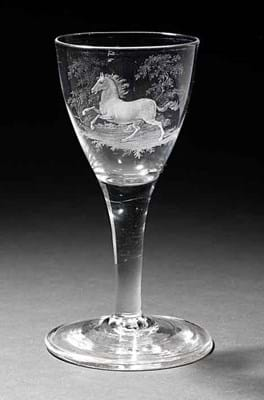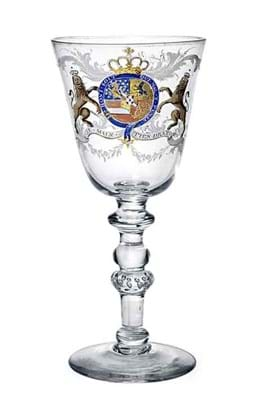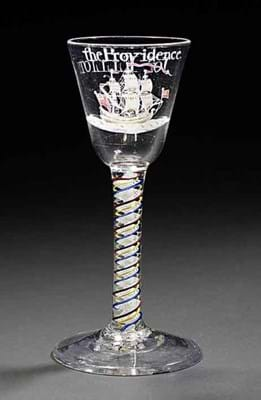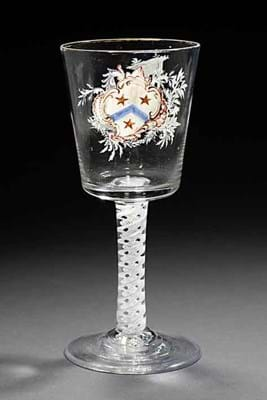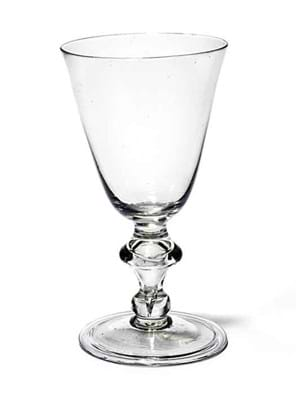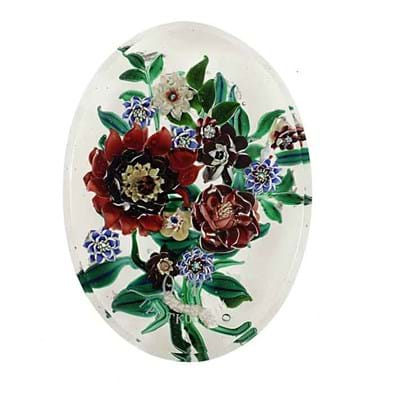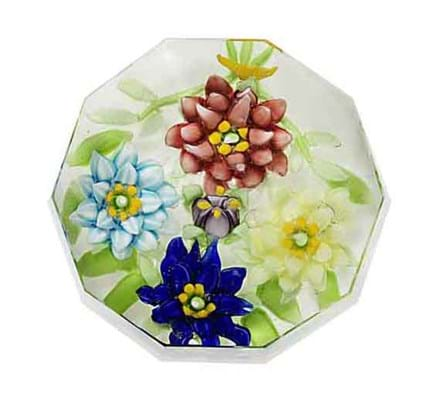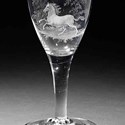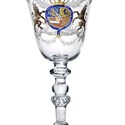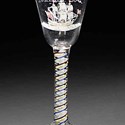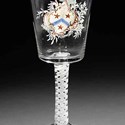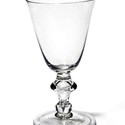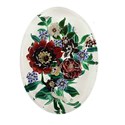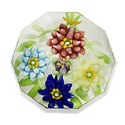The sale held by Bonhams (25/20/12% buyer's premium) in New Bond Street on November 30, 2011 was followed by a mixed-owner268-lot auction that was heavily slanted towards paperweights.
The Hubbard sale got away a very healthy 85 per cent of the material by volume. The mixed-owner auction immediately afterwards proved harder to shift or, more accurately, one sizeable American paperweight collection did, holding the selling rate down to 53 per cent.
Of course, there is always an attraction to a named provenanced collection, whether it was formed decades ago, or, like the Hubbard ensemble, relatively recently.
American A C Hubbard Jr, a retired international investments manager from Baltimore, first started collecting drinking glasses in the late 1980s after a trip to the collections at Mompesson House in Salisbury alerted him to their attractions. Already an enthusiastic wine collector, wine-related antiques complemented that interest.
With leading dealers as advisers and agents (notably Ward Lloyd, who subsequently published Hubbard's collection), he built up an impressive assemblage through auctions and the trade.
It was particularly strong in the fields of Beilby, colour twist and Dutch engraved glasses as well as featuring examples from the other specialist classes that interest glass enthusiasts: early balusters, wines with special shapes or engraving and Jacobite decoration.
Mr Hubbard continues to collect early wine bottles.
These are all well-trodden fields and, in the case of the Beilbys and colour twists, ones where prices were driven up dramatically at the turn of the 21st century thanks in no small part to interest from collectors like Mr Hubbard and Chris Crabtree.
When collectors turn vendors things can change. The dispersal of the Hubbard Beilbys and colour twists comes hot on the heels of those sold by Bonhams from the Crabtree collection from 2009-11.
Quantity of Buyers
So, two big players out of the running and substantial quantities back on the market over a relatively short space of time. Would there be enough buyers left to absorb it all?
Fortunately these are still areas with a body of collectors, mainly in the UK but also the US and countries like Australia. However, prices are not necessarily as high as a decade or so ago, especially for the colour twists, partly for the reasons outlined above.
And while demand is still there for Beilbys, many established collectors are well supplied with material and are only looking to fill gaps with sought-after rarities.
These market factors have to be taken into account alongside more standard considerations like rarity or condition when it comes to dispersing a collection. But there was also another consideration. As the Hubbard glasses had been imported from America for sale, all the lots attracted an additional five per cent premium on the hammer price, something that customers would be bound to factor in when bidding.
Given all this, estimate setting was key. One can compare estimates for some of Hubbard's glasses with prices made at their previous auction appearance. For example, a Beilby opaque twist wine enamelled in white with a typical Beilby scene of rustic buildings in an Italianate landscape, which had sold for £6200 at Sotheby's in 1993, was offered here with a £4000-6000 guide, while a colour twist firing glass sold for £2500 in Sotheby's 1998 auction of the Royal Brierley Collection appeared here with a £2000-3000 guide. They sold this time, incidentally, for £6500 and £1800.
The 85 per cent take-up rate suggests that Bonhams had mostly pitched the guides about right, and if the hammer prices were not always wildly over, or sometimes below, predictions that is probably partly because all the add-ons pushed the final price paid by the purchaser up by another 35 per cent.
Royal Goblet
There was, however, one lot where Bonhams did appear to have pushed the envelope. The star of the Hubbard sale was a signed Beilby enamelled Royal goblet of c.1766 decorated with the arms of the Nassau Princes of Orange for William V to one side and an opaque white butterfly and Beilby Newcastle Pinxit to the other. At 12in (30cm) high, this was an imposing piece, published in the Beilby literature and one of only 16 recorded heraldic glasses Beilby glasses with signatures.
An important piece then, in the Beilby corpus, but even so a £100,000-150,000 estimate was punchy and surely more than any Beilby glass has made at auction before. Bidding did not reach that level, for the goblet did not get away at the auction itself, although Bonhams negotiated a pretty swift after-sale to a private collector at £90,000, boosting the total for the sale up to just over £733,000.
Beilbys accounted for four of the ten highest Hubbard results. They included a pair of 10in (25cm) high, opaque twist covered goblets enamelled with trademark fruiting vines at £27,000 and a 6in (16cm) high privateer glass that combined an opaque and colour twist stem and was painted to the bowl with a three-masted sailing ship and the inscription The Providence Jon Elliott 1767. When last under the hammer at Christie's in 1999, this realised £26,000. Guided this time at £25,000-35,000, it got away at £24,000.
Another Beilby armorial glass, an 8in (20cm) high goblet, painted with a characteristic white classical ruin vignette and the polychrome arms of the Pollard family, went for £15,000, which was less than the £20,000-30,000 guide and the £25,000 that it realised when last sold at auction in 1998.
But there were also glasses in the Hubbard sale that outstripped expectations. The most expensive of the Hubbard colour twists was a c.1770, 6in (15cm) high wine glass with a stem featuring opaque white, blue and yellow threads. This outstripped its £8000-12,000 guide to take £16,000.
Of the 20-odd Dutch engraved glasses that rounded off the Hubbard sale, the most expensive was a 6in (15.5cm) high plain wine glass of c.1780-90 stipple engraved by David Wolff with a white horse in a meadow flanked by trees. It outstripped a £7000-9000 guide to take £17,000.
Further Highlights
Outside these three categories, among the other types featured in the collection, there was keen demand for another privateer glass which sold for double the estimate at £15,000. This was dated to c.1770, was 6½in (16.5cm) high, set on an opaque twist stem and engraved to the bucket-shaped bowl with a detailed view of a three master and the inscription Success to the Eagle Frigate John Knill Commander. This refers to a 24-gun, 250-ton ship jointly owned by Camplin and Smith of Bristol and Manslip and Wilkinson of London.
Early English drinking glasses of baluster form have been selling strongly for some time and Mr Hubbard had a particularly unusual version among his examples. It was small at just 4in (10cm) high and set on an short, inverted baluster stem with a large tear, but the funnel bowl was engraved over the entire surface with leafy sprays, while the rim carried the inscription God Save the Queen. Dated to c.1680-90, Bonhams had guided it at £7000-9000 only to see it make £20,000.
Mixed-Owner Sale
The mixed-owner sale that followed the Hubbard offering included a small selection of 18th century English glass, among which was another Beilby. This was a hitherto unrecorded 4in (10cm) high tumbler painted with flowers in white to one side and to the other a thistle surmounted by a crown with the legend Nemo me Impune Lacefsit (No-one attacks me with impunity), the motto of the Order of the Thistle. A Beilby ale glass featured in the Hubbard sale, which realised £10,000, was similarly decorated. This example made £10,500.
As mentioned, almost two-thirds of Bonhams' second sale was given over to paperweights. If buyers didn't warm to the larger of two private collections offered here, the 120-lot American consignment, the smaller, 37-lot Friedrich Bader collection of Russian paperweights and related objects generated much more enthusiasm, providing seven of the ten top prices. This sale happened to coincide with London's Russian auction series and consequently was well viewed by Russians, but in the event, said Bonhams, most of the lots were secured by paperweight specialists.
Many of the most expensive Russian pieces were paperweight plaques, including the best seller, a 5½in (14cm) long oval plaque illustrated on these pages. Dated to c.1870-80, inset with a floral arrangement of dahlias tied with a white caterpillar and engraved in Cyrillic O F Grotkowskij, it outstripped expectations of £12,000-18,000 to take £23,000.
The most expensive of the circular Russian weights was a rare, 3in (8cm) diameter specimen of the same period inset with a yellow winged butterfly surrounded by dahlias and wild strawberries guided at £7000-9000, that ended up making £11,500.

